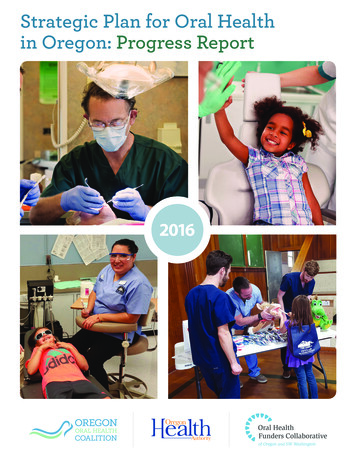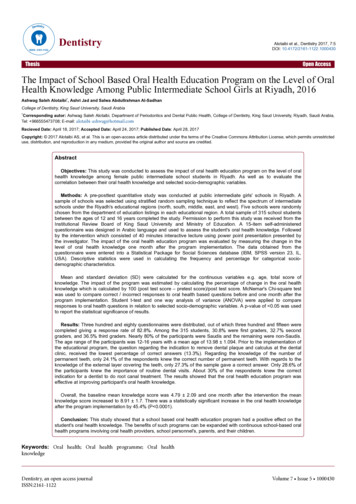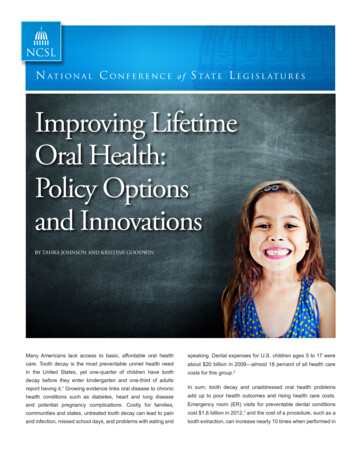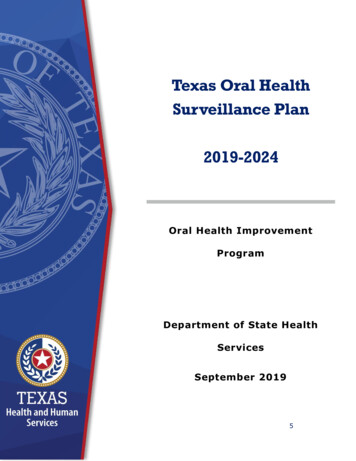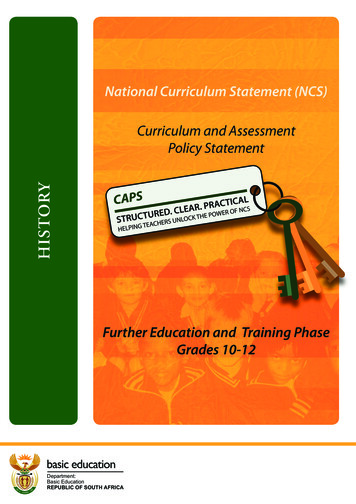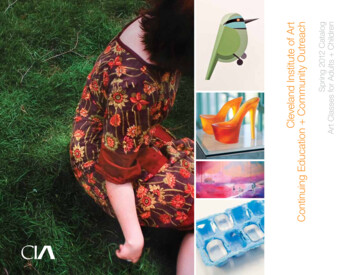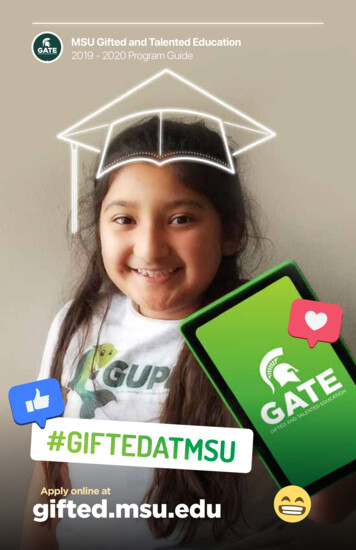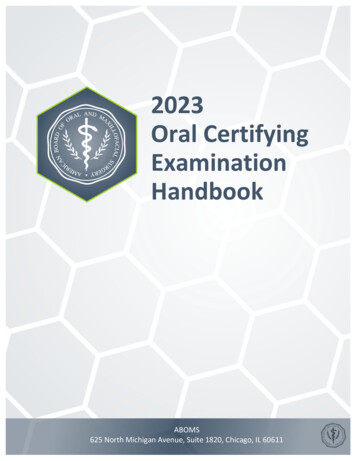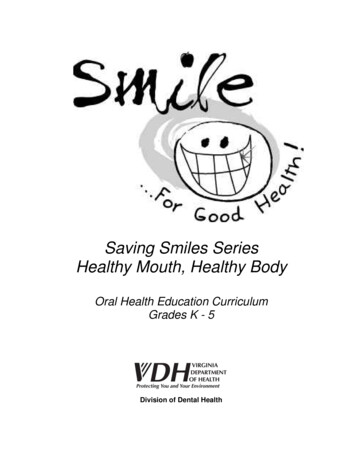
Transcription
Saving Smiles SeriesHealthy Mouth, Healthy BodyOral Health Education CurriculumGrades K - 5Division of Dental Health
Saving Smiles SeriesHealthy Mouth, Healthy BodyOral Health Education Curriculum - Grades K - 5IntroductionThe Health Education Standards of Learning (SOL) for the Virginia Public Schools,provide the framework for instruction of the knowledge and skills needed forstudents to lead healthy lives. The goal of this curriculum is to educate studentsabout the impact of personal hygiene on oral and overall health. Healthy childrenwho are free of dental pain will learn more effectively in the classroom. TheDivision of Dental Health, Virginia Department of Health endorses the concept ofemphasizing oral health as an integral part of total body health.Through this Saving Smiles Series, the Division of Dental Health believes thatoral health can be integrated throughout the child’s education. These moduleswere developed to help meet the Health Education SOL for the Virginia PublicSchools in grades K – 5.As a result of incorporating the Saving Smiles Series into the elementarycurriculum, the student will be able to do the following: Recognize the relationship between personal behavior and personal health,and have an understanding of oral health promotion and dental diseaseprevention.Demonstrate an ability to identify accurate oral health information and to beable to utilize this information to positively influence oral health and total wellbeing.Demonstrate a variety of oral health behaviors that promote healthy mouths,healthy bodies and healthy communities.The modules for grades K – 5 contain lesson plans which are designed in a “readyto go” format for the classroom teacher. Each lesson plan includes:- a related Health Education SOL- discussion information for the presenter- leading questions to engage the students- possible activities for students to assess knowledge/skills- resources for the teacher- grades 3-5: sample evaluation questionsA teacher evaluation/feedback form is included with the curriculum. This form canbe faxed to the Division of Dental Health. We appreciate your comments as youintegrate the oral health education information into classrooms. An additionalresource list is also included.
Saving Smiles SeriesHealthy Mouth, Healthy BodyOral Health Education Curriculum Grades K – 5Table of ContentsResource ListFeedback FormKindergarten ModuleLesson Plan (1) Explain why brushing teeth is an important daily task.Lesson Plan (2) Discuss which people in the community can answerquestions about teeth.First Grade ModuleLesson Plan (1) Identify the functions of healthy teeth.Lesson Plan (2) Demonstrate correct toothbrushing techniques for youngchildren.Lesson Plan (3) Demonstrate safe toothpaste use and proper toothbrushstorage.Lesson Plan (4) Identify nutritious meals, snack foods and beverages toimprove general and oral health.Lesson Plan (5) Identify the oral health professionals met during a dentalvisit.Lesson Plan (6) Follow school safety rules during activities to avoid dental andfacial injuries.Second Grade ModuleLesson Plan (1) Identify the parts of the oral cavity that are involved in thedigestive system.Lesson Plan (2) Develop an awareness of the long-term effects of choosingnutritious foods and beverages for a healthy life and self image.Lesson Plan (3) Describe plaque and its impact on dental diseases and selfimage.Lesson Plan (4) Identify the roles of oral health professionals met during a dentalvisit.Lesson Plan (5) with regular dental check-ups.Lesson Plan (6) Describe the effects on the body of using drugs, alcohol andtobacco products.Third Grade ModuleLesson Plan (1) Develop an awareness of how the nutrient content of food andbeverages affects body systems and can improve personalhealth.Lesson Plan (2) Describe the effects of nicotine products, including smokelesstobacco products, on body systems and the oral cavity.Fourth and Fifth Grade ModuleLesson Plan (1) Identify the components of a balanced meal and describecarbohydrates and their impact on oral health.Lesson Plan (2) Develop an awareness of community health resources availableto help prevent oral disease and improve total health.
Lesson Plan (3) Describe the causes of dental diseases including the role ofbacterial plaque, and describe how dental diseases can beprevented.Lesson Plan (4) Identify laws related to the purchase of tobacco products andDescribe the effects of tobacco on oral health and the body.
Oral Health Information Resources-American Academy of Pediatric Dentistry – www.aapd.org-American Dental Association – www.ada.org-American Dental Hygienists’ Association – www.adha.org-Division of Dental Health, Virginia Department of Health –www.vahealth.org/teeth-National Institute of Dental Research – www.nidr.nih.gov-National Maternal and Child Health – Oral Health Bright Futures Toolbox –www.mchoralhealth.org
Saving Smiles SeriesHealthy Mouth, Healthy BodyModule Feedback FormPresenter Name Date of PresentationSchool County GradePosition (eg., teacher, school nurse, volunteer)Estimated Time Presenting Number of ChildrenList Module(s) Used in Presentation:List Classroom Activities Used:Comments:Please FAX (804-864-7783) or mail form to:Sharon Logue, RDH, MPHDivision of Dental HealthVirginia Department of Health109 Governor St. – 9th FloorRichmond, VA 23219Thank you!
Saving Smiles SeriesHealthy Mouth, Healthy BodyKindergarten ModuleOral Health Education CurriculumThis kindergarten module includes two lesson plans. As a result ofimplementing this module the student will accomplish the following objectives:1. Explain why brushing teeth is an important daily habit. (SOL K.2b and c)2. Discuss what people in the community can answer questions about teeth.(SOL K.4b)
Saving Smiles SeriesHealthy Mouth, Healthy BodyKindergartenLesson Plan – #1Explain why brushing teeth is an important daily habit.(SOL K.2 b,c)Standard of Learning K.2 – The student will explain the concept of being healthy.Key concepts/skills include:b) personal hygiene practicesc) germs (e.g., bacteria, viruses) that lead to common diseasesDiscussion information for the presenter – Health habits formed by youngchildren are more likely to be continued into adolescence. Children learn aboutwashing hands to remove germs and a comparison can be made with cleaningplaque germs from teeth and gums. Plaque bacteria causes both dental decay andperiodontal (gum) disease. Young children are at greater risk for dental decaywhich is the most prevalent chronic disease of children. Daily toothbrushing is animportant habit for young children to adopt, and reinforcement at home by parentsis essential. Parents can role model good oral health habits for their children anddiscuss why dental visits are important.Fine motor skills are not fully developed with young children and toothbrushingtechniques can vary. Most children can demonstrate a circular method of brushing.Basic concepts of top and bottom, and front and back teeth can be emphasized.Encourage children to “tickle” their gums as they brush to remove more germs atthe gumline. Chewing surfaces or “wrinkles” on back teeth (molars) are at higherrisk for decay because food and bacteria can hide in the crevices. These molarsneed special attention everyday to avoid cavities. Parents can discuss dentalsealants with their dentist as children grow and their permanent molars erupt.Brushing should be done a minimum of twice daily, before coming to school and atnight prior to bedtime. Children who frequently drink sugary beverages and eatsugary foods need to brush more often.
Leading questions: Why is it important to brush teeth?How many times a day should you brush your teeth?What can happen to teeth if you do not brush them every day?Possible activities to assess students’ knowledge/skills:1. If a sink is available, students could demonstrate brushing (toothpaste is notnecessary).2. Using large brushing models, the student can demonstrate the correctbrushing techniques on the teeth.3. *Write a song about how to brush. Then have the students march aroundthe room as they sing it.4. Draw a picture about why a healthy smile is important.5. *Clear a floor area and give each student a long piece of colored yarn, putthem in small groups and have them shape their yarn pieces into the shapeof a healthy tooth or smile. When completed have children walk around andlook at each other’s work with the yarn.*For total wellness and obesity prevention we encourage teachers to considermovement with some of the learning activities.Estimated time for presentationA minimum of 10 minutes to a maximum of 20 minutes is needed depending on thenumber of activities included.Resources- “Your Child’s Teeth” and “How To Brush” brochures and coloring books fromDivision of Dental Health, Virginia Department of Health: www.vahealth.org/teeth
Saving Smiles SeriesHealthy Mouth, Healthy BodyKindergartenLesson Plan – #2Discuss which people in the community can answer questions about teeth.(SOL K.4b)Standard of Learning K.4 – The student will identify sources of health and safetyinformation. Key concepts/skills include:b) individuals, including school nurses, family members, health care personnel,teachers, and public safety officials.Discussion information for the presenter:- Young children are practicing newhabits that will keep them safe and healthy throughout life. They are also learningto find answers to questions from parents, family and trusted adults. Regularmedical and dental visits are opportunities for children to ask questions about theirhealth and bodies and get reliable health information. School nurses are excellentresources for students also as they learn about safety rules and health issues.Leading questions: Who could you visit in the community to check your teeth?Who could tell you how to take care of your teeth?Who could you talk to at school if you have a question about your teeth?Who talks about safety rules at school?Have you ever asked your parents about your teeth?Possible activities to assess students’ knowledge and skills:1. Invite a dental team member to come to class and answer questions aboutdental health.2. Have the children write a question to ask the school nurse about how to stayhealthy.3. Have the children draw a picture of a person who they would feelcomfortable asking health questions.
Estimated time for presentationA minimum of 10 minutes to a maximum of 20 minutes is needed depending on thenumber of classroom activities included.Resources-“How to Brush” brochure and “Visiting the Dentist” coloring book from Division ofDental Health, Virginia Department of Health: www.vahealth.org/teeth
Saving Smiles SeriesHealthy Mouth, Healthy BodyFirst Grade ModuleOral Health Education CurriculumThis first grade module includes six lesson plans. As a result of implementingthis module the student will accomplish the following objectives:1. Identify three functions of healthy teeth. (SOL 1.1b)2. Demonstrate correct toothbrushing technique for young children. (SOL 1.2a)3. Demonstrate safe toothpaste use and proper toothbrush storage.(SOL 1.2a)4. Identify nutritious meals, snack foods and beverages to improve general andoral health. (SOL 1.2f)5. Identify the oral health professionals met during a dental visit.SOL 1.5a and b)6. Follow school safety rules during activities to avoid dental and facial injuries.(SOL 1.3a, b, c and h; SOL 1.6a, b and c)
Saving Smiles SeriesHealthy Mouth, Healthy BodyFirst GradeLesson Plan – #1Identify three functions of healthy teeth.(SOL 1.1b)Standard of Learning 1.1 – The student will identify the major body systems andexplain their connection to personal health. Key concepts/skills include:b) the digestive system.Discussion information for the presenter – The oral cavity is the beginning ofthe digestive system. The first step of digestion is the mastication (chewing)process. Teeth are different sizes and shapes for different functions. Incisors arefor cutting, canines are for tearing, and premolars and molars are for crushing andgrinding foods. Other functions of healthy teeth include speaking, smiling, andproviding structure for facial support.Humans have two sets of natural teeth in a lifetime: deciduous (primary) andpermanent. First graders normally have 20 primary teeth prior to the eruption ofpermanent teeth. A complete permanent dentition includes 32 teeth. Primary teethinclude incisors, canines and molars. Permanent teeth include incisors, canines,premolars and molars.Leading questions: Who has teeth?Do animals have teeth?What do teeth do?Have you lost any teeth?How many sets of natural teeth do you have during your life?How long are your adult teeth going to last?Possible activities to assess students’ knowledge/skills:1. Using small hand mirrors have children look in their own mouths.2. Have pictures of animals to identify the different shapes and types of teeth.(e.g., beavers and rabbits for incisors, dogs for canines, and horses formolars)
3. Bring in a variety of nutritious foods and have students eat the foods to seewhat teeth they use. (biting an apple with their incisors)4. Show pictures of babies eating soft foods.5. Create a lost tooth club or poster in the classroom.6. Have the students draw a smile at different ages to indicate how many teeththey will have.7. Tell a story about losing a tooth.8. Create a letter to the tooth fairy describing how they plan to take care oftheir new teeth.Estimated time for presentationA minimum of 10 minutes to a maximum of 30 minutes is needed depending on thenumber of activities included.Resources- “Your Child’s Teeth” brochure and coloring books from Division of Dental Health,Virginia Department of Health: www.vahealth.org/teeth
Saving Smiles SeriesHealthy Mouth, Healthy BodyFirst GradeLesson Plan – #2Demonstrate correct toothbrushing technique for young children.(SOL 1.2a)Standard of Learning 1.2 – The student will explain that good health is related tohealth-promoting decisions. Key concepts/skills include:a) personal hygiene; including care of one’s teeth.Discussion information for the presenter: The purpose of toothbrushing is toremove bacterial plaque and food, thus reducing the risk for dental diseases: dentaldecay (cavities) and periodontal (gum) disease. Bacterial plaque is the causativeagent for both diseases. Young children are at greater risk for dental decay.Dental decay is the most prevalent chronic disease of young children. There arethree factors necessary for decay to occur: an erupted tooth, a carbohydratesource in the mouth and bacteria.The mechanical action of toothbrushing adequately removes the sticky plaque andfood from tooth and gum surfaces. Toothbrushes need to be replaced at leastevery 3 months or when the bristles become frayed. A first grade student needs asmaller size brush head with soft bristles.Fine motor skills are not fully developed with young children. Toothbrushingtechniques may differ for different age groups. Most young brushers can handle acircular method of brushing. Students need to brush three surfaces of each tooth:the outside surface, the inside surface and the chewing surface. General conceptsof front teeth, back teeth, top and bottom teeth need to be emphasized with youngchildren. Encourage children to “tickle” their gums as they brush. Chewingsurfaces of back teeth may be referred to as “wrinkles” – the chewing surfaces areat higher risk for dental decay because food and bacteria can hide in the crevicesor “wrinkles.” Cleaning the tongue during toothbrushing removes more bacteria.Children should gently brush the top of their tongue using a downward stroke.Brushing should be done a minimum of twice per day. The most important time tobrush is at night prior to bedtime. Young children need adults to assist withbrushing once a day at home. Toothbrushing should take about 2 minutes.Children who frequently drink sugary beverages and eat surgery foods need tobrush more often.
Leading questions: Why do we brush our teeth?How many times a day do you brush your teeth?How do you brush your teeth?Should you use anyone else’s toothbrush?What parts of your teeth do you brush?Possible activities to assess students’ knowledge and skills:1. If a sink is available, students could demonstrate brushing. (toothpaste is notnecessary)2.*Have each student stand up and act as a tooth so that the entire class forms arow of top teeth or bottom teeth. Then with a large demonstration brush, astudent demonstrates correct brushing. The waist could represent thegumline.3. Using brushing models, the student can demonstrate the correct brushingtechnique on the large teeth.4. Draw a picture of what happens when you do not brush your teeth.5. Send disclosing tablets home with children to stain the plaque red prior to.brushing.6.*Write a class song about how to brush. Then have students march around theroom as they sing it.7. Develop a classroom brushing challenge and offer prizes.8 .Arrange a toothbrush exchange – bring in an old toothbrush for a new one.9. View a videotape on correct toothbrushing.*For total wellness and obesity prevention we encourage teachers to considermovement with some of the learning activities.Estimated time for presentationA minimum of 10 minutes to a maximum of 30 minutes is needed depending on thenumber of classroom activities.Resources-Videotapes for the classroom from American Dental Association: www.ada.org-“How to Brush” brochure from Division of Dental Health, Virginia Department ofHealth: www.vahealth.org/teeth
Saving Smiles SeriesHealthy Mouth, Healthy BodyFirst GradeLesson Plan – #3Demonstrate safe toothpaste use and proper toothbrush storage.(SOL 1.2a)Standard of Learning 1.2 – The student will explain that good health is related tohealth-promoting decisions. Key concepts/skills include:a) personal hygiene; including care of one’s teeth.Discussion information for presenter – Bacterial plaque and food can beremoved by a toothbrush and water alone. Adding toothpaste does assist incleansing the teeth and freshening the breath. Brushing is more effective inreducing dental decay when fluoride is an ingredient in the toothpaste. A smallamount of fluoride toothpaste is recommended for children. Toothpaste was neverintended to be a systemic (swallowed) source of fluoride. Children need to beinstructed to expectorate (spit out) the toothpaste after brushing. Routinelyswallowing excess fluoride toothpaste while permanent teeth are still developingunder the gums may lead to a condition called fluorosis. Fluorosis is characterizedby white or brown spots in the enamel surface of permanent teeth. This stainingcannot be removed because it occurred while the teeth were developing. A peasize amount of fluoride toothpaste is the appropriate amount for youngchildren.Bacteria collect on toothbrush bristles. Once brushing is completed, the brushshould be rinsed with water and left to air dry. An airtight toothbrush cover over thewet bristles contributes to the growth of bacteria. Replace brushes every 3 – 4months, more frequently if the brush becomes frayed or worn. Even familymembers should not share toothbrushes.With classroom brushing programs, the toothbrushes need to be stored in amanner that permits air-drying and spacing so brushes do not touch. Label allbrush handles with the child’s name in permanent marker. Give each child adisposable cup for rinsing. When dispensing toothpaste for a group of children withone tube of toothpaste, dispense a pea-size amount of toothpaste on the edge ofthe cup for the child to wipe off with their individual toothbrush.
Leading questions: How does your family store their toothbrushes in the bathroom?How much toothpaste do you use at home?Why do we use toothpaste?Do you eat fluoride toothpaste?Do you know what happens if you eat too much toothpaste?Possible activities to assess students’ knowledge/skills:1. If a sink is available, students could demonstrate brushing using toothpaste.2. Have students practice dispensing a pea-size amount of toothpaste on apaper plate.3. Bring in different toothpastes and look for the word fluoride on the label.4. Use a coloring sheet showing steps in correct brushing and storage oftoothbrush.5. Make a classroom toothbrush holder.6. Bring different types of toothbrush covers to show children.7. Demonstrate correct and incorrect storage of toothbrushes. (put severalbrushes in one bathroom cup and have bristles touching)Estimated time for presentationA minimum of 10 minutes to a maximum of 30 minutes is needed depending on thenumber of activities included.Resources-Consumer information on toothbrushes and toothpastes from American DentalAssociation: www.ada.org-“How to Brush” brochure from the Division of Dental Health, Virginia Departmentof Health: www.vahealth.org/teeth
Saving Smiles SeriesHealthy Mouth, Healthy BodyFirst GradeLesson Plan – #4Identify nutritious meals, snack foods and beverages to improve general andoral health.(SOL 1.2f)Standard of Learning 1.2 – The student will explain that good health is related tohealth-promoting decisions. Key concepts/skills include:f) proper nutritionDiscussion for the presenter – Healthy, pain-free teeth are needed to chewnutritious foods. Healthy diets can help prevent dental diseases and contribute tooverall health. Carbohydrates (simple and complex sugars) combined withbacteria on teeth lead to dental decay. Research has shown that the frequencythat teeth are exposed to both bacteria and carbohydrates is an important factor inthe development of new decay. Children require frequent snacking for propergrowth. Choosing the correct foods, beverages and snacks is essential to reducingthe risk for both dental decay and childhood obesity.Factors to consider about between meal snacks are the simple sugar content, thefrequency it is eaten, the texture of the food and the nutritional content. Sugarsin foods and beverages are used by bacterial plaque to create acid that dissolvestooth enamel. Limit sweet treats for children to once a day at home where thetoothbrush is close by. Crisp, crunchy fruits and vegetables do not adhere asreadily to the teeth and they provide essential vitamins and minerals. Soft, stickyfoods will cling to the teeth longer. Snacking with nutritious, low-fat choices willcontribute to overall health. As with any food or beverage served, appropriateportion sizes for snacks need to be followed.Offer thirsty children water to drink. Water is not only calorie-free but providesadditional fluoride if the community has fluoridated water. Offer calorie-containingbeverages (milk and fruit juice) at meal times only to help maintain a healthy bodyweight. Limit the availability of soft drinks to children. Most regular 12-ouncesodas contain 10 – 12 teaspoons of added sugar.A healthy snack suggestion is fresh fruit and cheese. Cheese (e.g., Jack,Cheddar, Swiss) has been shown by dental research to interfere with the acidicaction of bacterial plaque on enamel. Cheese also contains calcium for developingbones and teeth. Fresh vegetable sticks, nuts and popcorn are other possible
Resources-Food models, posters and pamphlets from National Dairy Council:www.nationaldairycouncil.org-“A Healthy Diet is Something to Smile About” - brochure from the Division ofDental Health/VDH: www.vahealth.org/teeth-“Fruits and Vegetables For Me” website with coloring sheets and facts on foodswww.fandvforme.com.au
snacks. Offering low-fat cheese or bean dips with vegetables can be a strategy toencourage trying new foods.Leading questions: What is your favorite snack after school?Why should you brush your teeth after snacking?What are some healthy drinks?Can you name some fruits and vegetables?Should you snack right before a meal is served?If you snack on surgary foods what can happen to your teeth?Possible activities to assess students’ knowledge/skills:1. Have a taste-testing party introducing new, healthy snacks or ethnic foods.*Before tasting have students march to music around the room to “wake up”their appetites.2. Place real foods in a grab bag and have children put their hand in the bag toidentify shape and feel without looking.3. *Walk to school vending machines and let children point out healthy andunhealthy snacks/beverages for teeth and total health.4. Develop a board game where students match unhealthy foods to unhealthyteeth and healthy foods to healthy teeth.5. *Divide the blackboard into two sides with a picture of a happy tooth and asad tooth with a cavity. Have a relay with children sticking pictures of foodsand beverages in the right category.6. Read labels of favorite foods and drinks looking for different sugars. (4grams 1 teaspoon of sugar) Then demonstrate actual sugar content offoods and beverages with teaspoons of sugar.7. Create a paper buffet with pictures of foods, food models and paper plates.Students then make meals on the paper plates.8. *Have students create a snacking “rap song” and have children march asthey sing.9. Develop a healthy snack challenge for children to bring to school.*For total wellness and obesity prevention we encourage teachers to considermovement with some of the learning activities.Estimated time for presentationA minimum of 10 minutes to a maximum of 30 minutes is needed depending on thenumber of activities included.
Saving Smiles SeriesHealthy Mouth, Healthy BodyFirst GradeLesson Plan – #5Identify the oral health professionals you meet during a dental visit.(SOL 1.5a and b)Standard of Learning 1.5 – The student will identify the health care providers andagencies that influence personal health. Key concepts/skills include:a) the role of community health care professionals;b) the purpose of community health care agencies.Discussion for the presenter – Regular dental and physical examinations areneeded to monitor growth and development in children. The first dental visit couldimpact oral health for the remainder of the child’s life. It is important that the childnot be fearful of dental professionals. Classroom activities can help prepare thechild for regular dental visits and alleviate any fear of the unknown. With regularoffice visits a child will become familiar with the roles of each oral healthcareprovider. Children should visit the dentist by their first birthday, for a visual exam tobe sure there are no early problems. After the age of three, children should beseen by the oral healthcare provider at least twice per year.The dentist usually has the highest education level and holds a professionallicense. The dentist diagnoses dental diseases and provides restorative care, likefillings. The dental hygienist is a licensed prevention specialist, whose primary roleincludes health education and preventive care for teeth and gums. The dentalassistant may be certified, usually works directly with the dentist or hygienist toassist in their respective procedures and can provide some preventive procedures.Leading questions: Who has been to a dental office?What good things happened when you went to the dentist?How often should we go to the dentist?Who works in the dental office and what do they do?Possible activities to assess students’ knowledge/skills:1. Role play a visit to the dental office with lab coats, masks, gloves, flashlightsand tongue depressors.2. Write a story or draw a picture about their visit to the dental office.
3. Develop a game matching the healthcare provider with their respectiveduties.4. Schedule a field trip to a local dental office or clinic with a dentist, dentalhygienist and dental assistant.5. Write a letter to parents telling what they learned about each healthcareprovider.6. Have the teacher/parent videotape his/her trip to the dentist. Watch the tapein class and discuss the activities with the children.7. Invite a dentist, dental hygienist or dental assistant to the classroom to givea presentation on job roles and oral health.Estimated time for presentationA minimum of 10 to a maximum of 30 minutes depending on the number ofactivities included.Resources-Local private dental offices and community/public health dental clinics for field trips-Coloring books about visiting the dentist from Division of Dental Health, VirginiaDepartment of Health: www.vahealth.org/teeth-Videotape on visiting the dental office from the American Dental Association:www.ada.org
Saving Smiles SeriesHealthy Mouth, Healthy BodyFirst GradeLesson Plan – #6Follow school safety rules during activities to avoid dental and facial injuries.(SOL 1.3a, b, c and h; SOL 1.6a, b and c)Standard of Learning 1.3 – The student will explain the need for specific rules andpractices to promote personal safety and injury-free situations. Key concepts/skillsinclude:a) bus and automobile safety;b) pedestrian safety;c) playground safety;h) the need for protective gear.Standard of Learning 1.6 – The student will demonstrate responsible personaland social behaviors in the school community. Key concepts/skills include:a) cooperative behavior;b) respect for others;c) adherence to school rulesDiscussion for the presenter – Injuries to the mouth and face (orofacial injuries)are common among school age children. Part of personal safety is adhering toschool safety rules and regulations. Learning appropriate behavior at a young agewill promote injury-free situations. Cooperative behaviors on school property areimportant skills to learn. Orofacial injuries could result from one push at a waterfountain, putting pens or pencils in the mouth or throwing a ball at head and faceareas.If a young child has a primary front tooth knocked out, a cold compress should beapplied. With an older child, if a permanent tooth is avulsed (knocked out), placethe tooth in milk and seek immediate dental treatment. Avoid handling the toothas much as
improve general and oral health. Lesson Plan (5) Identify the oral health professionals met during a dental visit. Lesson Plan (6) Follow school safety rules during activities to avoid dental and facial injuries. Second Grade Module Lesson Plan (1) Identify the parts of the oral cavity that are involved in the digestive system.
